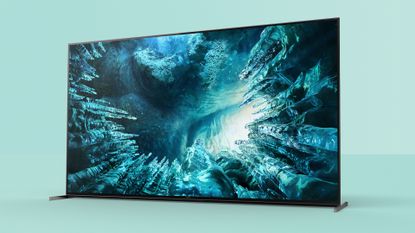Welcome to T3's Sony ZH8 (UK) / Z8H (US) review. While Samsung might have the biggest range of 8K TVs, Sony isn’t about to let it have new market to itself. In fact, Sony’s new 75ZH8 8K TV is a more price-competitive contender than the brand’s eye-wateringly expensive previous 8K option, the ZG9, and just about matches the Samsung Q950TS at the same size.
Of course, that still makes this damn expensive, but there's no doubt you'll see the money up on the screen. This is easily one of the best TVs around right now for the sheer beauty of its images, and it's even shockingly good for audio, in case you happen to be planning to buy a 75-inch TV and not pairing it with a sound system.
Let's dig into why it's so good, where it has the edge on the competition, and where it falls a little short.
Sony ZH8 review: Price & features
The Sony 75ZH8 can currently be yours for £5,499/$5,999. This is, of course, very much not cheap at a time when you can get a good Sony 75-inch 4K TV for less than half that, or the Samsung Q800T 8K TV for £3,499/$3,299 at 75 inches. The ZH8 is also available as an 85-inch model – you can see the latest prices on it at all sizes right here.
Still, good as the Samsung Q800T is, it does leave room for Sony to deliver enough extra performance to justify its extra cost to anyone lucky enough to be able to think about buying one.
Helping the 75ZH8 make its Q800T-beating case right away is its use of a Full Array with Local Dimming (FALD) LCD panel featuring 320 separate dimming zones. This is almost 100 more separately controllable zones than you get with the Q800T, promising much more localised light control and, as a result, hopefully better contrast. Especially with challenging high dynamic range (HDR) content.
Having a local dimming system that truly fires on all cylinders will be especially important on the 75ZH8 given that its brightness on a 10% (screen area) white HDR window comfortably measures above 2000 nits. This makes Sony’s TV one of the brightest released to date (though amazingly, the previous Sony ZG9 was actually almost twice as bright). The 75ZH8’s contrast should also benefit from its use of a VA type of LCD panel, rather than an IPS one.
Video processing is always an especially big deal with 8K TVs given that native 8K content is currently pretty much non-existent. It’s reassuring, then, to find the 75ZH8 carrying an 8K-tuned version of Sony’s redoubtable X1 Ultimate premium processor.
This has many strings to its bow, including super bitmapping to reduce HDR colour banding, object-based HDR remastering for converting SDR sources to HDR, dynamic backlight power controls that let power be rerouted from dark areas to bright ones, and Sony’s X-Motion Clarity processing.
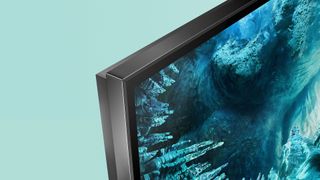
This latter feature inserts black frames into 24 frames a second movies to create a more cinematic look to motion without the brightness loss that usually accompanies such technology. Perhaps the single most important X1 Ultimate processor feature, though, is its upscaling. This draws on a huge database of image analysis to enhance the way the 75ZH8 adds the necessary tens of millions of extra pixels to sub-8K pictures in real time.
The 75ZH8’s HDR support covers the HDR10, HLG and Dolby Vision formats. There’s no HDR10+, as ever with Sony TVs. And unlike the cheaper Sony XH9005 series, the Dolby Vision system uses the ‘source led’ DV profile that tends to deliver slightly inferior results to the more common ‘display led’ approach.
The 75ZH8 falls down a bit with its 8K support. For while the set carries a native 8K pixel count, it can’t play 8K files from USB drives, or 8K streams. Only one of its four HDMIs can play 8K at 60Hz (this one port can also handle 4K at 120Hz, which the others can't), too. This means that your only 8K options right now are a high-end PC fitted with one of the latest top-of-the-line Nvidia or AMD graphics cards, or maybe one of the new games consoles if they live up to their 8K promises (at the time of writing, they haven't). But only have one port means you could only have one next-gen games console outputting the maximum 4K at 120fps they can already do.
Perhaps even more strangely, even the 8K-capable HDMI port on the 75ZH8 can’t handle the variable refresh rates and automatic low latency mode switching features the latest games machines deliver. Despite Sony’s mid-range XH9005 TV range doing so on not one but two HDMI ports, and Samsung's Q950TS happily offering this on its one HDMI 2.1 port.
Getting back into positive feature territory, the 75ZH8 features a swanky new ‘Acoustic Multi-Audio’ audio system. This combines vibrating frame tweeters built behind its top left and right sides along with a new design of powerful, internal refraction-removing main speakers in its bottom edge to deliver a much larger and precise soundstage than TVs usually provide. Or you can opt to use the TV’s speakers as the centre channel in a separates speaker system.
As you would hope with so many speakers at its disposal, the 75ZH8 carries built-in Dolby Atmos decoding.
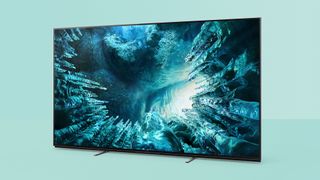
Sony ZH8 review: Picture quality
The 75ZH8 delivers the best picture quality I’ve seen from an LCD TV released so far. In fact, if you’re the sort of person who prefers the brightness LCD can deliver to the sort of contrast and black levels OLED TVs specialise in, the 75ZH8 is arguably the best performing TV of 2020, period.
For starters, its pictures really are spectacularly bright. Bold HDR images erupt off the screen in a way only a couple of other much more expensive TVs – Samsung’s Q950T and Sony’s even more expensive ZG9 – can compete with. The brightest highlights of HDR images look fantastically intense, while bright daylight scenes are light enough to make you feel like you’re looking through the window rather than watching a TV.
The intensity and impact of the 75ZH8’s pictures isn’t just down to its exceptional brightness, though. Outstanding management of the screen’s 300-plus dimming zones means that despite its brightness the 75ZH8 can serve up seriously deep and rich black tones, even where dark image areas have to share space with bright highlights.
What’s more, where an intense highlight stands out against a dark backdrop, the highlight doesn’t have its brightness hammered by the local dimming system in a bid to keep the dark areas looking perfect (as happens with Samsung’s 2020 local dimming TVs). Instead, Sony opts to maintain bright highlights pretty much untamed, to gorgeously dynamic effect.
There is a trade off for this in the shape of mild backlight halos around stand-out bright objects. This is less widespread and thus much less likely to distract, though, than it was on Sony’s flagship 4K TVs, the XH9505s, which only get around 60 separate dimming zones.
Making the 75ZH8’s unashamedly bold approach to HDR playback all the more exciting is the way its extreme brightness feeds into dazzlingly rich and vibrant colours. The set’s colour volume - the shades a screen can achieve through the combination of its brightness and its colour range - is immense, meaning there’s no sign of the colour bleaching you can get where a screen’s brightness tracks ahead of its colour palette.

This enables it to unlock more of the full potential of even the most aggressively mastered HDR/wide colour gamut sources than almost any other screen I’ve seen bar Sony’s own expensive ZG9s.
It’s not just at the extremes of its pictures that the 75ZH8 excels, though. It’s also deft enough with its colour and light management to reproduce pretty much flawless amounts of fine detail and subtle shading in even the most heavily saturated areas of HDR pictures. Similarly, in dark picture areas the 75ZH8 holds on to so much subtle shadow detailing that it’s hard to reconcile with the 75ZH8 being an LCD TV (and therefore not a screen that can offer pixel-level light control).
The 75ZH8’s sharpness and detail are excellent with 4K sources. As it has many times before, Sony’s database-driven upscaling does a remarkably good job of remapping lower resolution content to the screen’s native pixel count, clearly increasing the detail and density in 4K sources while simultaneously suppressing/removing source noise.
The picture starts to soften a bit with HD sources – as it does on all 8K TVs. The 75ZH8’s upscaled HD image is still pretty watchable, but if you’re going to invest so much in Sony’s set you also owe it to yourself to invest in as many 4K (at least) sources as you can.
The 75ZH8’s impressive sharpness remains intact when there’s motion to deal with, too, thanks to the excellent motion processing options the X1 Ultimate processor provides. Your best bet here is to choose the ‘Custom’ Motionflow option and set the Smoothness and Clearness options to Min and a couple of notches above Min respectively.
The 75ZH8’s native 8K playback, surprisingly, isn’t quite as crisp and detailed as some I’ve seen. Almost as if whatever limitations in its HDMI chips or video processing bandwidth prevent it supporting VRR are maybe also somehow impacting its 8K video bandwidth. It’s important to stress, though, that 8K pictures still look routinely beautiful, providing a poignant reminder that great picture quality isn’t only about resolution.
The 75ZH8’s stellar colour and contrast hold up better from fairly wide viewing angles than they do on most LCD TVs too (though the halos of backlight clouding around stand-out bright objects become more noticeable the wider the viewing angle you find yourself at).
Given that the 75ZH8 is built from the ground up to excel with HDR content, it’s a treat to find that the HDR upconversion system Sony provides for SDR content works remarkably well. The colour and light range are both clearly expanded, but subtly enough to ensure that the results look natural and engaging rather than gaudy or forced.
Aside from the slight 8K softness and occasional minor backlight cloud, the 75ZH8’s only other issue is that it can sometimes lose subtle detail in the brightest parts of HDR pictures. This really does only happen with the most extreme HDR content, though, and since it’s a result of Sony taking a ‘purer’ approach to rendering HDR than most TVs, it’s very easy to live with in the context of how great the image looks in every other way.
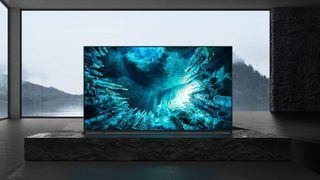
Sony ZH8 review: Sound quality
While the 75ZH8’s pictures are its star attraction, its Acoustic Multi-Audio system is a pretty close second. The first thing that strikes you is how huge and open its sound is. The main speakers create a room-filling, forward-presenting sound that swells massively from the moment it starts to escape from Sony’s innovative new drivers.
The dynamic range is extreme enough to rival many external soundbars, with smooth, deep bass at one end; crisp, clean treble details at the other; and a startlingly full, open mid-range in between that can handle even the most excessive action scene without sounding fragile or muddy.
The tweeters high up on the set’s rear left and right edges do a great job, too, of introducing a sense of verticality to Dolby Atmos soundtracks, and genuinely making sound effects appear locked not just to the screen, but the correct place on the screen. They even manages to track noisy objects as they move around the screen.
This sense of audio height and onscreen placement is particularly helpful with dialogue, which always sounds clear but well contextualised, no matter how much of a racket might be going on behind it.
Sony ZH8 review: Design and usability
The 75ZH8’s design is all subtlety, restraint and minimalism. From the front the frame around the screen looks extremely trim, distracting scarcely at all from the pictures within. Its feet, too, are simply slim metal bars that can be fixed side on to the screen’s bottom corners, where they become extensions of the metal trim around the TV’s outer edge, or closer together in a flat orientation for people looking to mount their TV on a narrow piece of furniture.
Since the screen sits right down low on the feet when they’re in their close together configuration, you again barely notice they’re there. The set’s rear is fairly chunky by today’s standards, thanks to the set’s high quality direct LED lighting system. The rear’s a bit plasticky, but it does boast extensive detachable covers to help you hide cabling, and also boasts an unusual ‘textured grid’ finish.
The 75ZH8 isn’t the easiest TV to use. Sony has tried to enliven its set up menus by introducing some pretty if sometimes rather random graphics, but the integration of the set up options with an Android TV smart system can sometimes feel complicated and counterintuitive.
The Android smart system itself still has things about it I’m not a big fan of. Including a home menu that fills the whole screen, a rather long-winded shelf-based presentation, and a less ‘personal’ feel than I tend to get with other smart TV systems. I experienced a couple of ‘hangs’ when using the Android menus, too.
Following the recent addition of support for Apple TV, though, Sony’s Android TV implementation does cover pretty much every video streaming app most UK users could ever need. Including Netflix, Disney+, Amazon Prime Video and others.
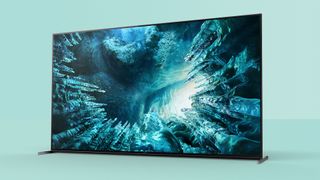
Sony ZH8 review: Verdict
While the Sony 75ZH8 looks a bit expensive for a TV that doesn’t deliver fully on its 8K promise and lacks a couple of key next-gen gaming features, it delivers quite possible the best picture quality available right now, and arguably the best sound quality.
It's absolutely at the peak of what's being offered for huge home theatre 8K TVs right now – the image quality is just astounding, particularly if what you want is something that can make non 4K HDR footage look as impactful as possible.
The Samsung Q950TS is maybe a more future-proofed choice for connecting other devices, because its ports support Variable Refresh Rate and Auto Low Latency Mode, while also offering staggering HDR and upscaling from 4K to 8K. But that model doesn't offer Dolby Vision support for HDR, so you can basically decide whether game-friendly features are your priority or having a more widely supported next-gen HDR format.

